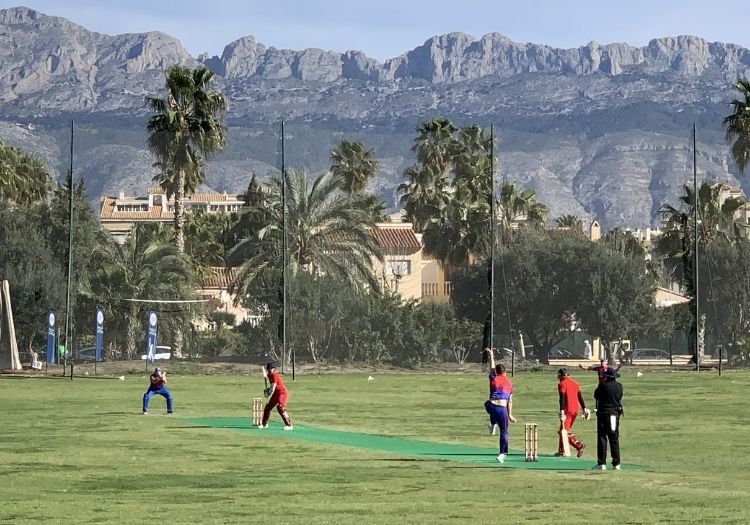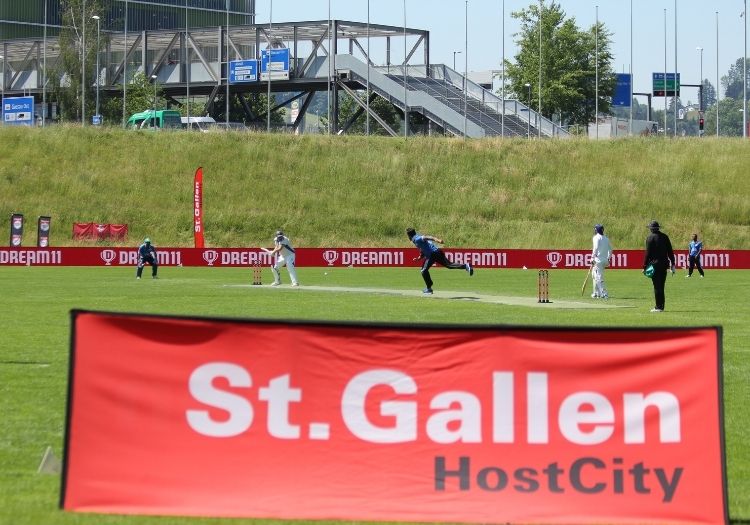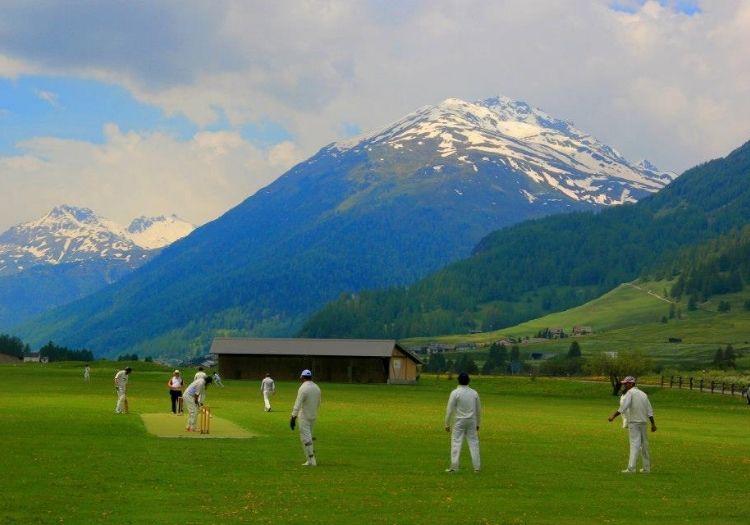JAMES COYNE: The European Championships could occupy the cricket window in early October. But can it cut through to a continental audience?

Come October 1, the destination of the County Championship title, the Bob Willis Trophy and the Vitality Blast will all be known – and there’ll be just one show left in town prior to the T20 World Cup in India.
Surely you can’t carry on playing cricket into October in the northern hemisphere, though?
Well, you do in the Mediterranean.
Last year, the cricket ‘season’ went on well into November in Barcelona, and not long before Christmas in Malta, though even that was disrupted by rain in the end.
And come autumn, the European Cricket Championships, no less, will be reaching its climax somewhere in Spain.
Thanks to the unheralded but undeniable obsession with cricket on the continent – especially among those of a South Asian background – it’s been possible for the European Cricket Network to run tournaments seemingly 365 days a year. Between January 2020 and now – even during a pandemic – there have been almost 40 European club cricket tournaments, mainly T10, administered by the ECN, all broadcast on television or live-streamed.
The ECN’s founder is Daniel Weston, a hedge fund manager and former Western Australia Under-19 wicketkeeper/batsman who settled in Munich a few years ago.
He deliberately chose to build this European Cricket Series around existing cricket clubs – his rationale being that historic multi-sport clubs are the bedrock of sport in continental Europe, and that new franchise identities won’t have the same cut-through.
But the ECN’s recently announced diversification into a European Championship – between national teams rather than recreational clubs – is a new twist on an old favourite.
Pavel Florin: Twitter fame, Transylvania and a night at The Oval
Fifteen countries are set to send national teams of varying strength to the 2021 Euros: Italy, Denmark, Germany, Austria, Norway, Romania, Spain, Sweden, Belgium, Hungary, Czech Republic, Portugal and Finland. Scotland are sending an A-side.
And yes, England will have a team too; you suspect among the fine cricketers in the National Counties (formerly the Minor Counties) there will be serious clamour to be picked in the amateur England XI… the bonus of a late summer holiday in Spain won’t hurt.
Netherlands, Jersey and Guernsey are notable absentees from the list.
A European Championship of cricket – along the lines of football’s Euros – is nothing new. In actual fact, it was The Cricketer magazine that sponsored and helped organise the first such tournament – the 1990 European Cricketer Cup. (This was just one part of an incredible portfolio of recreational competitions organised by the tireless proprietors of the magazine, the Brocklehurst family. The Cricketer still runs one of them, the Voneus Village Cup.)
The Cricketer came along at the right time, as cricket was popping up all over Europe due to the waves of globalisation and immigration and the collapse of the Soviet bloc.
The first European Cricketer Cup was held in sleepy Guernsey, but still there was one flashpoint when a France batsman and a West Germany bowler squared up to each other. It was smoothed over by the tournament organisers, though Clive Ellis in the Daily Telegraph poked fun at this testing of the “entente cordiale” in European cricket.
Like most Associate cricket, the European Cricketer Cup was not exactly lavishly funded, with France and Belgium unable to send some of their best players due to financial constraints, and Austria bunking up in sleeping bags in the camp beds of the Elizabeth College Scout Hut.
Still, the involvement of the Brocklehursts ensured an old-world air, with a gala dinner for 300, a special visit from ICC chairman Colin Cowdrey, a Vin d’Honneur, a cheese and wine party and real ale tasting.
The top prize on offer for the winners – Guernsey, who beat Belgium in the final – was a challenge match against MCC at Lord’s.
Two years later, the champions, a unified Germany, flew their flag at Lord’s for the first time, when they took on an MCC team featuring none other than the England striker Gary Lineker.

European Cricket Network matches are popping up all over the continent
Lineker, who had just bowed out from international football at Euro 92, and was bound for Nagoya Grampus Eight in Japan, kept wicket and scored 1. "I always get one against the Germans," he quipped as he walked back in through the Pavilion. Germany’s last pair clung on for a draw in an old-style declaration game.
It was remarked at the time that this was a Germany team containing no obviously German names, though that obscured the fact that the Deutscher Cricket Bund were one of the most energetic Associate boards in developing local cricketers. That same year Germany did put out a national XI containing eight German citizens and two naturalised players against a similarly homegrown Italy side.
But the difficulty in producing competitive locally born-and-raised cricketers who can genuinely mix it with emigres who learned their cricket in a Commonwealth country is still perhaps the single toughest issue in most Associate nations. Though, as the general secretary of the Serbian Cricket Federation, Vladimir Ninkovic, says: "It is a long, time-consuming process and nerve-consuming process, but far from impossible. All other sports did it."
The European Cricket Federation – which had been set up to expand participation – started their own European Nations Cup, staged between 1993 and 1997 variously in Berlin, Oxford, Osnabruck (an old British garrison town in Germany, and, as all geeks know, the birthplace of Hampshire and England’s Paul Terry) and Zuoz (in the sheer majesty of the Engadin Alps in Switzerland). (I know just how glorious Zuoz is, as I played there for Carmel & District CC in the 2013 Zuoz International Cricket Festival.)
The European Nations Cup was unusual in that it insisted on the participation of a certain number of citizens in each country’s XI – even if they tended to be shunted to the bottom of the batting card and scarcely bowled.
It is best remembered for an incredible final between France and Germany at Zuoz in 1997, included in a Wisden list of the 100 Greatest Cricket Matches of the 20th Century.
France batted first, and No.11 David Bordes, from Marmande in the Sud-Ouest, came in during the last of the 50 overs to face Germany’s bowler Saeed. Bordes usually wore a helmet but decided this time it wasn’t necessary for just a few balls. But one delivery reared up and struck him on the head. He staggered down to the other end for a leg bye and shortly afterwards collapsed with a fractured skull.
No.10 Valentin Brumant was bowled next ball. But the leg-bye Bordes staggered in getting France to a total of 267 would prove crucial.
Germany needed two to win off the last ball of the match. Saeed skied it, and he and Christian Musfeldt scampered what would have the winning runs while the ball was in the air… only for mid-on Brumant to take the catch and give France the title by one run.

Venues in Europe are nothing if not picturesque
Imagine all that being shared on social media these days? It hardly bears thinking about.
As for Bordes, he spent a fortnight in hospital but wasn’t put off cricket: he was back playing indoors before Christmas, went on to be an administrator for France Cricket and now works for Cricket Scotland.
Where was the ICC through all this time, you might ask? Well, it wasn’t until the mid-1990s that they became the global governing body with oversight for the Associate nations. Gideon Haigh has called that period the ICC’s “brief dalliance with League of Nations-like idealism” as they added new members by the score from every corner of the world.
In 1998, the ICC moved in with its own European Championship, which was popular, and has since morphed into the T20 World Cup regional qualification process, which will also take place in three pools across Europe this summer.
The ICC do deserve praise for (finally) making it possible for all Associate nations to qualify for the T20 World Cup.
But, in putting so much at stake in their Associate competitions, the incentive to include locals into national XIs has ebbed away, as performances on the field have become key to qualification for the next stage of tournaments and receiving funds from Dubai. There’s also plenty of legal and ethical questions about enacting rules which stop certain people who live in a country from representing it.
This brings us up to the present-day, and the re-emergence of a European Championship officially sanctioned by the ICC, though run privately by the European Cricket Network.
The fact it’s being broadcast does rather dictate the format: the very digestible T10. (The genteel days of the Brocklehursts and declaration matches do seem longer than 30 years ago.)
When the ECB felt they had to dream up a shorter format than T20 for its "new competition", the BBC commentator Kevin Hand argued in The Cricketer that they should have chosen T10 rather than The Hundred – a fifth format nobody else plays. T10 might also work best for an Olympic cricket tournament if it ever happens.
Tinder, cigars and tears: The making of the inaugural European Cricket League
And T10’s timescales do seem logical when operating in a European market accustomed to 45-minute halves of football.
(It’s certainly not the optimum playing format, mind. If you’re playing T10, you’d better make sure you’re batting in the top four, or can turn your arm over…)
Up until November last year, ECN cricket was shown live on FreeSports, which is available to virtually anyone with a digital box, and free on YouTube everywhere outside India. The viewing figures during the Covid summer were astounding.
The two marquee tournaments are, at the moment, the European Cricket League in May and June, effectively the Champions League of European club cricket; and the European Cricket Championships this in September/October. Both ought to feature the best players from each participating country.
But even then the standard of the cricket does veer from spectacularly agile to spectacularly… well, average. The playing standard in domestic ECS events is a notch lower. Much of the attraction comes from the sheer novelty of seeing cricket played, say, in a baseball ground next to the Barcelona Olympic Stadium.
How to incorporate local cricketers, whose experiences of learning an alien game in their native country might win over more new recruits, can be a difficult poser if you want to sell a sport at its highest standard.
And the ECN do have their own local hero. In the 2019 ECL, social media – with its characteristic pile-on, followed by a backlash – turned Pavel Florin, a nightclub bouncer and bodybuilder from Cluj, Romania, into a cult figure.
And the promotional aspect of the ECN seems almost to rely as much on fantasy cricket competitions as actual runs and wickets.

European cricket looks set to become a greater part of the sport's tapestry
Weston and other evangelists for Associate cricket would argue, with some justification, that all this is a means to an end – namely the popularisation of cricket in Europe. And they have surely gone some way towards that already.
There are, though, legitimate concerns about the potential for corruption when illicit money from illegal Indian gambling dens is waved in front of amateur cricketers who are not especially well-off.
Any cricket shown on TV or live-stream and able to be bet on is theoretically vulnerable to spot-fixing, after all. (That’s food for thought even for recreational clubs in the UK keen to live-stream their matches.)
And only a few weeks into its 2020 summer restart, the ECN banned a team from ECS Cyprus after suspicious behaviour had led the organisers to suspend a match halfway through. Around $2m was traded on the match on Betfair alone; arrests in Jaipur, India followed.
The Cricketer has been told that the ICC’s Anti-Corruption Unit is investigating suspected alleged corruption in at least two European countries related to ECN events last year. In Associate countries, the cricketing infrastructure (not just the anti-corruption infrastructure) is simply not as strong as it is in Full Member countries, but it will have to catch up if all this is going to be televised.
Weston himself admits there are "growing pains" in projecting amateur cricket in a professional manner. As in all transition periods, some strange things are happening, the full extent of which will only become clear when the history of the T20 revolution is written years from now. Let us hope those early concerns are teething problems which the game will grow out of quickly.
And bravo to the ECN for fully grasping the digital possibilities of this age, where the ICC had been unable or unwilling to. What the ECN undeniably offers is a portfolio of their best (and worst) cricket to splash all over social media and sell the sport. And, as those who work in cricket’s new media will tell you, it’s bitesize clips that is the route to winning over the next generation.
I personally wonder how often a click on a short clip converts into people actively taking up the game themselves… and that goes for whether you live in Andover or the 13th Arrondissement. But maybe that’s a debate for another day.
Either way, the viewers – whether new to cricket or someone like me – need to believe that what they are watching is genuine. That will be even more important once proud European sporting nations are being represented on the cricket field in October.